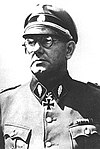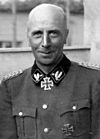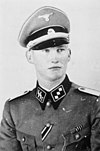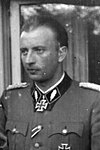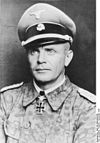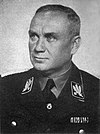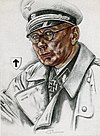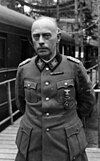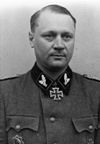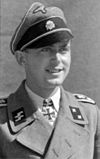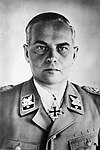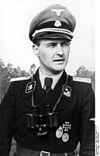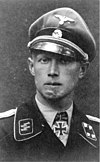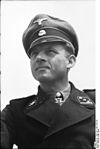List of Knight's Cross of the Iron Cross recipients of the Waffen-SS

The Knight's Cross of the Iron Cross (German: Ritterkreuz des Eisernen Kreuzes) and its variants were the highest award in the military and paramilitary forces of Nazi Germany. During World War II, 457 servicemen of the Waffen-SS, including volunteers and conscripts from Belgium, Croatia, Denmark, Estonia, France, Hungary, Latvia, Netherlands and Norway, received the Knight's Cross of the Iron Cross. Of these, 411 presentations were formally made and evidence of the award is available in the German Federal Archives. One recipient, Hermann Fegelein, was court-martialed and executed on 29 April 1945. According to German law he was deprived of rank and all awards previously. Fegelein must therefore be considered a de facto but not de jure recipient. A further 46 Knight's Cross, 8 Knight's Cross with Oak Leaves and 4 Knight's Cross with Oak Leaves and Swords recipients are either lacking the evidence to sustain their listings or received the award under questionable legal terms. All of them were accepted by the Association of Knight's Cross Recipients (Ordensgemeinschaft der Ritterkreuzträger des Eisernen Kreuzes e.V.) as legitimate recipients.[1]
The Oberkommando der Wehrmacht kept separate Knight's Cross lists, one for each of the three military branches, Heer (Army), Kriegsmarine (Navy), Luftwaffe (Air force) and for the Waffen-SS. Within each of these lists, a unique sequential number was assigned to each recipient. The same numbering paradigm was applied to the higher grades of the Knight's Cross, one list per grade.[2]
Background
[edit]The Knight's Cross of the Iron Cross and its higher grades were based on four separate enactments. The first enactment, Reichsgesetzblatt I S. 1573 of 1 September 1939 instituted the Iron Cross (Eisernes Kreuz), the Knight's Cross of the Iron Cross and the Grand Cross of the Iron Cross (Großkreuz des Eisernen Kreuzes). Article 2 of the enactment mandated that the award of a higher class be preceded by the award of all preceding classes.[3] As the war progressed, some of the recipients of the Knight's Cross distinguished themselves further and a higher grade, the Oak Leaves to the Knight's Cross of the Iron Cross, was instituted. The Oak Leaves, as they were commonly referred to, were based on the enactment Reichsgesetzblatt I S. 849 of 3 June 1940.[4] In 1941, two higher grades of the Knight's Cross were instituted. The enactment Reichsgesetzblatt I S. 613 of 28 September 1941 introduced the Knight's Cross of the Iron Cross with Oak Leaves and Swords and the Knight's Cross of the Iron Cross with Oak Leaves, Swords and Diamonds.[5] At the end of 1944 the final grade, the Knight's Cross of the Iron Cross with Golden Oak Leaves, Swords, and Diamonds, based on the enactment Reichsgesetzblatt 1945 I S. 11 of 29 December 1944, became the final variant of the Knight's Cross authorized.[6]
Recipients
[edit]The list is initially sorted alphabetically.
This along with the * (asterisk) indicates that the Knight's Cross was awarded posthumously.
This along with the ? (question mark) indicates that author Veit Scherzer has expressed doubt regarding the veracity and formal correctness of the listing.
Notes
[edit]- ^ Adolf Ax's nomination shows no indication that the request had been processed or granted, not even an entry date is noted. The nomination list indicates that the request was filed on the 28 April 1945. A Heerespersonalamt (HPA—Army Staff Office) nomination with the number 5092 had been created. The nomination, according to the book "Verliehene Ritterkreuze" (Awarded Knight Crosses), was forwarded to the HPA on 25 April 1945. No proof exists that the Knight's Cross was awarded. The Order Commission of the Association of Knight's Cross Recipients (AKCR) processed this case in 1981 and decided: Knight's Cross yes, 9 May 1945. Ax was a member of the AKCR.[11]
- ^ No evidence of the award can be found in the German Federal Archives. The award was unlawfully presented by SS-Oberstgruppenführer Sepp Dietrich. The date is taken from the announcement made by the 6. SS-Panzerarmee. Bastian was a member of the Association of Knight's Cross Recipients (AKCR).[13]
- ^ No evidence of the award can be found in the German Federal Archives. The award was unlawfully presented by SS-Oberstgruppenführer Sepp Dietrich. The date is taken from the announcement made by the 6. SS-Panzerarmee. The sequential number "153" was assigned by the Association of Knight's Cross Recipients (AKCR). Bittrich was member of the AKCR.[19]
- ^ No evidence of the award can be found in the German Federal Archives. According to Krätschmer the award was presented together with the Oak Leaves to Matthias Kleinheisterkamp. Presumably the announcement was made via radio transmission on 28 April 1945 from the Führer Headquarters in Berlin to the 9. Armee (9th Army) in the Halbe pocket. The radio transmissions received by the AOK 9 (Armeeoberkommando 9 — high command of the 9th army) in April 1945 were not retained. All communication to the Führerbunker in Berlin were out of order as of 5AM on 28 April. The order commission of the Association of Knight's Cross Recipients (AKCR) processed the case in 1981 and decided: "Knight's Cross yes, 28 April 1945", Friedrich Blond was a member of the AKCR.[20]
- ^ No evidence of the award to Karl-Heinz Bühler can be found in the German Federal Archives. The award was presumably awarded by SS-Oberstgruppenführer Sepp Dietrich, which would make it an unlawful presentation. The Order Commission of the Association of Knight's Cross Recipients (AKCR) processed this case in 1977 and decided: Knight's Cross no, 1 May 1945. The case Bühler was again processed in the fall of 1983. Whether or not additional or new evidence materialized remains unknown. The Order Commission decided this time: Knight's Cross yes, 8 May 1945. Von Seemen lists him on 7 May 1945, Krätschmer states 1 May 1945. Fellgiebel later re-dated the award on the 6 May 1945. It remains subject to speculation why this was done. Bühler was a member of the AKCR.[11]
- ^ No evidence of the award can be found in the German Federal Archives. The award was unlawfully presented by SS-Oberstgruppenführer Sepp Dietrich. The date is taken from the announcement made by the 6. SS-Panzerarmee. Draxenberger was a member of the Association of Knight's Cross Recipients (AKCR).[34]
- ^ No evidence of the award can be found in the German Federal Archives. The award was unlawfully presented by SS-Oberstgruppenführer Sepp Dietrich. The date is taken from the announcement made by the 6. SS-Panzerarmee. Franz Josef Dreike was a member of the Association of Knight's Cross Recipients (AKCR).[34]
- ^ No evidence of the award can be found in the German Federal Archives. Presumably the award was presented by SS-Oberstgruppenführer Sepp Dietrich which would make it an unlawful presentation. The date was assumed by Fellgiebel. Von Seemen states the 23 November 1944. The author was denied access to files, which could help clarify the case, of the Association of Knight's Cross Recipients (AKCR) on the grounds of the Bundesarchivgesetz (German Archive Law). Oskar Drexler was a member of the AKCR.[34]
- ^ No evidence of the award can be found in the German Federal Archives. The author was denied access to files, which could help clarify the case, of the Association of Knight's Cross Recipients (AKCR) on the grounds of the Bundesarchivgesetz (German Archive Law). Paul Egger was a member of the AKCR.[34]
- ^ Hermann Fegelein was sentenced to death by Hitler and executed by SS General Johann Rattenhuber's RSD on 28 April 1945 after a court martial led by SS-Brigadeführer and Generalmajor of the Waffen-SS Wilhelm Mohnke. The sentence was carried out the same day. The death sentence resulted in the loss of all orders and honorary signs.[40]
- ^ A lawful presentation via the chain of command to the chief of the Heerespersonalamt (HPA—Army Staff Office) Wilhelm Burgdorf in Berlin submitted nomination is possible. Also possible is a direct presentation by Adolf Hitler. However no evidence of the award can be found in the German Federal Archives. The author was denied access to files, which could help clarify the case, of the Association of Knight's Cross Recipients (AKCR) on the grounds of the Bundesarchivgesetz (German Archive Law). Fellgiebel wrote in a letter dated 31 August 1976: "...He (Willhelm Fey) after joining the Bundeswehr has request a court of honor against himself. Chairman was our companion recipient of the Oak Leaves former Oberst XXXX (name was made anonymous). This court of honor has accepted him without evidence". The order commission of the AKCR accepted this. Fellgiebel wrote: "...we don't want to claim that we are smarter than the Bundeswehr." Willhelm Fey was a member of the AKCR.[41]
- ^ Alfred Fischer's nomination, according to a file card, was received by the Heerespersonalamt (HPA—Army Staff Office) on 11 January 1945. The nomination, according to the book "Verliehene Ritterkreuze" (Awarded Knight Crosses) and note on the file card, had been rejected without specifying a date. A HPA nomination was not created. Fischer received the Honour Roll Clasp of the Army on 5 March 1945 which may have result of the rejected Knight's Cross nomination. The nomination by the troop is missing, which may be an indication that it had been forwarded to the Referat Vg (responsible for the Honour Roll Clasp listings). The presentation date is an assumption of the Association of Knight's Cross Recipients (AKCR). Krätschmer states the 9 May 1945.[42]
- ^ No evidence of the award can be found in the German Federal Archives. Presumably the award was presented by SS-Oberstgruppenführer Sepp Dietrich which would make it an unlawful presentation. The date 6 May 1945 was assumed by Fellgiebel. Von Seemen states the 3 May 1945. Kurt Fröhlich is not mentioned in Krätschmer's book. The author was denied access to files, which could help clarify the case, of the Association of Knight's Cross Recipients (AKCR) on the grounds of the Bundesarchivgesetz (German Archive Law).[45]
- ^ Roberts Gaigals' nomination had been finalized by the Heerespersonalamt (HPA—Army Staff Office) and was ready for signature by the end of the war. According to the Association of Knight's Cross Recipients (AKCR) the award was presented in accordance with the Dönitz-decree. This is illegal according to the Deutsche Dienststelle (WASt) and lacks legal justification. The presentation date is an assumption of the AKCR.[46]
- ^ No evidence regarding the presentation of the Knight's Cross of the Iron Cross to Karl Gebhard can be found in the German Federal Archive. Fellgiebel also had no evidence and wrote on 11 July 1983 to Mr. Eichhorn: "I have to rely on Krätschmer in Rieflin Fritz's case, as well as in Gebhard's.". Krätschmer may have his information from Hermann Buch, the former IIa (personnel administration) of the 2. SS-Division "Das Reich", who mentioned the name Gebhard in a letter to von Seeman on 6 December 1970. Unlawful presentation by SS-Oberstgruppenführer Sepp Dietrich. The date is taken from the announcement made by the 6. SS-Panzerarmee.[47]
- ^ Karl-Heinz Gieseler is listed as a recipient in Fellgiebel as SS-Untersturmführer and Stoßtruppführer in Berlin as a member of the 11. SS-Panzergrenadier-Division "Nordland".[48] Fellgiebel himself states that the presentation was made by SS-Brigadeführer Wilhelm Mohnke in the bunker of the Reichs Chancellery between 25 – 30 April 1945. The number of likely presentations varies between 3 and 5 soldiers. No evidence of the award can be found in the German Federal Archives. Gieseler is not listed by Scherzer.[49]
- ^ No evidence of the award can be found in the German Federal Archives. According to Krätschmer the action took place in March 1945 in Pomerania with the Army Group Vistula. Von Seemen lists Herbert Golz with the footnote: "Source: Generalmajor (Pol.) Rode, at the time chief of staff with the chief of the German Police". This posting is not verifiable. A SS-Brigadeführer and Generalmajor Rode is verifiable and was chief of staff of the field commando of the Reichsführer SS. This field commando processed at the time the nominations of the Waffen-SS and prepared them for approval by Heinrich Himmler. These nominations at the time were received by SS-Obersturmbannführer Kment, the adjutant of Himmler and liaison officer to the Heerespersonalamt (HPA—Army Staff Office). Golz nomination could have been a unlawful presentation by Himmler as commander in chief of the Army Group Vistula. The order commission of the Association of Knight's Cross Recipients (AKCR) handled this case in 1977 and decided: "Knight's Cross yes, 31 March 1945". The evidence sustaining this decision remains unclear. Access to the files was denied on the grounds of the Bundesarchivgesetz (German Archive Law). The presentation date was later changed by Fellgiebel. Golz was a member of the AKCR.[50]
- ^ No evidence of the award can be found in the German Federal Archives. According to Fellgiebel the award was presented by SS-Oberstgruppenführer Sepp Dietrich, which would make it an unlawful presentation. Fellgiebel's sources are Hermann Buch and Wilhelm Kment. According to Buch—note from 25 June 2005—he has nothing to do with this presentation. And Kment cannot be the source, since Buch stated that Kment died in the early 1970s (Wilhelm Kment actually died on 15 November 1984). If Kment were the source then von Seemen would have listed Heinz Gropp in either the first or second edition of his book, which is not the case. The source thus remains uncertain. Krätschmer lists Gropp in his third edition with a date of 1 May 1945 without stating a source as well. Fellgiebel dated the award on 6 May 1945. He may have done this to justify this as a Dietrich award.[53]
- ^ The recommendation for Franz Hack's Oak Leaves to the Knight's Cross was submitted to the Heerespersonalamt (HPA—Army Staff Office) by the Division sometime between 16 and 19 April 1945 and approved by the commander of the IV. SS-Korps Herbert Otto Gille. Missing is the approval from the 6. Armee and Heeresgruppe Süd. There is no indication whether the recommendation was approved. The response from the Reichsführer-SS was prepared but missing is a date and signature. The existing card is not contemporary. There is no indication in the press that the award was presented. According to Fellgiebel Hack received the Oak Leaves from SS-Obergruppenführer and General of the SS Herbert-Otto Gille, commanding general IV. SS-Panzerkorps. The sequential number "844" and date of award were assigned by the Association of Knight's Cross Recipients (AKCR).[57]
- ^ No evidence of the award can be found in the German Federal Archives. Presumably Desiderius Hampel received the Knight's Cross the same day as Karl Liecke and Hans Hanke. Letter from Krätschmer to von Seemen dated 7 August 1980. According to von Semen presumably presented by General Maximilian de Angelis. The Order Commission of the Association of Knight's Cross Recipients (AKCR) processed Hampel's case in 1980 and Fellgiebel decided: Knight's Cross yes, 3 May 1945. In his book he noted: "A justification for the presentation was not given". Hampel was a member of the AKCR.[58][59]
- ^ No evidence of the award can be found in the German Federal Archives. Hans Hanke, according to Krätschmer, was informed of the award by SS-Brigadeführer Desiderius Hampel and SS-Obersturmbannführer Karl Liecke. Both Hampel and Liecke supposedly received the Knight's Cross the same day—Letter from Krätschmer to von Seemen dated 7 August 1980. Mr Meentz of the German Federal Archive stated on 20 July 2004 that it cannot be verified that Hanke received the Knight's Cross. According to von Seemen the Knight's Cross was awarded by General Maximilian de Angelis. The order commission of the Association of Knight's Cross Recipients (AKCR) processed the case in 1980 and Fellgiebel decided: "Knight's Cross yes, 3 May 1945". Nevertheless Fellgiebel noted: No justification for the award.[58][59]
- ^ No evidence of the award can be found in the German Federal Archives. According to Krätschmer—letter dated on 7 August 1980 to von Seemen— the presentation was made in conjunction to the Oak Leaves presentation to Matthias Kleinheisterkamp and was announced via radio transmission on 28 April 1945 from the Führer Headquarters in Berlin to the 9. Armee (9th Army) in the Halbe pocket. The radio transmissions received by the AOK 9 (Armeeoberkommando 9 — high command of the 9th army) in April 1945 were not retained. All communication to the Führerbunker in Berlin were out of order as of 5AM on 28 April. The order commission of the Association of Knight's Cross Recipients (AKCR) processed Kurt Hartrampf's case in 1980 and decided solely relying on the letter from Krätschmer: "Knight's Cross yes, 28 April 1945", Hartrampf was a member of the AKCR.[57]
- ^ No evidence of the award can be found in the German Federal Archives. According to Krätschmer—letter dated on 7 August 1980 to von Seemen— the presentation was made in conjunction to the Oak Leaves presentation to Matthias Kleinheisterkamp and was announced via radio transmission on 28 April 1945 from the Führer Headquarters in Berlin to the 9. Armee (9th Army) in the Halbe pocket. The radio transmissions received by the AOK 9 (Armeeoberkommando 9 — high command of the 9th army) in April 1945 were not retained. All communication to the Führerbunker in Berlin were out of order as of 5AM on 28 April. The order commission of the Association of Knight's Cross Recipients (AKCR) processed Edgar Hauckelt's case in 1980 and decided solely relying on the letter from Krätschmer: "Knight's Cross yes, 28 April 1945".[61]
- ^ No evidence of the award can be found in the German Federal Archives. The award was unlawfully presented by SS-Oberstgruppenführer Sepp Dietrich. The date is taken from the announcement made by the 6. SS-Panzerarmee. Hauser was a member of the Association of Knight's Cross Recipients (AKCR).[61]
- ^ The nomination by the troop was received by the Heerespersonalamt (HPA—Army Staff Office) via teleprinter on 6 April 1945. This can be verified in the book "Verliehene Ritterkreuze" (Awarded Knight Crosses) and file card. A HPA nomination was never created or was not retained and according to the file card the nomination was numbered Nr. 5023 and forwarded for further processing. The file card indicates no further information. The presentation date according to Krätschmer was the 6 May 1945. Mr Meentz of the German Federal Archive stated on 20 July 2004 that it cannot be verified that Hans Havik (Johann Havik according to Scherzer) received the Knight's Cross. The presentation date 9 May 1945 was assigned by Fellgiebel.[62]
- ^ Mr Meentz of the German Federal Archive stated on 20 July 2004 that it cannot be verified that Ludwig Hoffmann received the Knight's Cross. The presentation date was assigned by Fellgiebel. Krätschmer lists him on 9 May 1945. Hoffmann was a member of the Association of Knight's Cross Recipients (AKCR)[66]
- ^ According to Scherzer on 20 April 1945[68]
- ^ Heinz Jürgens' nomination by the troop was received by the Heerespersonalamt (HPA—Army Staff Office) sometime between 23 and 27 April 1945 and prepared for signature with a presentation date of 28 April 1945. However it was never signed. According to the Association of Knight's Cross Recipients (AKCR) the award was presented in accordance with the Dönitz-decree. This is illegal according to the Deutsche Dienststelle (WASt) and lacks legal justification. Jürgens was a member of the AKCR.[70]
- ^ No evidence of the award can be found in the German Federal Archives. Fellgiebel claimed that Paul-Albert Kausch, at the time wounded in the Reich Chancellery, had received news that according to a radio message received from Panzer AOK 11 had been awarded the Oak Leaves on 23 April 1945 from SS-Brigadeführer Joachim Ziegler. Ziegler, the Division commander of Kausch, was killed in action on 1 May 1945. Krätschmer however indicated that Kausch was wounded 25 April, therefore he couldn’t have received the news on the 25 April. The 11th SS Volunteer Panzergrenadier Division Nordland was only subordinated to the 11th Panzer Armee in February 1945. The Stab of the 11th Panzer Army then relocated to the Western Front where it surrendered on 21 April. Krätschmer claimed that the award was presented for the actions during the middle of April east of Berlin. Mr. J.S. Fischer, who was verifying the Oak Leaves presentation on behalf of Fellgiebel is not aware of a radio message received from the Panzer AOK 11. Fischer indicated that he only referenced the information presented by Kausch, which is already stated in Krätschmer. According to information by Fischer on 14 October 2004, Fellgiebel had made the note about the Panzer AOK 11. The sequential number "845" was assigned by the Association of Knight's Cross Recipients (AKCR), according to Krätschmer the number is "846", the date was accepted by the AKCR. Kausch was member of the AKCR.[70]
- ^ No evidence of the award can be found in the German Federal Archives. Also never processed by the Order Commission of the Association of Knight's Cross Recipients (AKCR). According to von Semen presumably presented by General Maximilian de Angelis on the basis of the Dönitz-decree. Fellgiebel noted in his book: "A justification for the presentation was not given".[58][79]
- ^ Fellgiebel claims that the nomination was received by the Heerespersonalamt (HPA—Army Staff Office) via teleprinter from the commander-in-chief of the 9. Armee, general Theodor Busse, on 21 April 1945. Busse had nominated SS-Obergruppenführer Kleinheisterkamp for the Oak Leaves. The claim is that the teleprinter contained a note that the formal procedure for immediate approval should be waited for (Dienstwegvorschlag bzgl. Sofortverleihung abwarten). This teleprinter message cannot be found in the German Nation Archives (Bestand RH 7). Busse had also nominated by teleprinter Generalmajor Joachim von Siegroth on the 21 April. This teleprinter message can be found in the Nation Archives (Bundesarchiv RH 7/300). According to Fellgiebel the same note can be found on von Siegroth's nomination. This means that a formal nomination, in this instance via the Army Group Vistula, followed. Both announced "formal nominations" never followed and were never received by the HPA. The teleprinter nomination of von Siegroth is listed in the book of "awarded Knight Crosses" with an entry date of 21 April but Kleinheisterkamp's nomination isn't. The reason for this may be that the liaison officer of the Waffen-SS at the HPA/P5a may have forwarded the nomination to the Reichsführer-SS for approval. From here it should have been returned to the HPA which it wasn't. The distribution list of von Siegroth's nomination indicates that general Busse had informed the Army Group Vistula and the chief of the HPA general Wilhelm Burgdorf. It is very likely that Kleinheisterkamp's nomination had the same distribution list as von Siegroth's, because the same principles applied. Burgdorf therefore should have been informed of the formal procedure regarding Kleinheisterkamp's nomination. The question remains unanswered whether the Führer Headquarter or Adolf Hitler has approved the direct nomination of Kleinheisterkamp on 28 April or not. Scherzer claims that this is very unlikely because Burgdorf would not have done two things. First, submit a nomination to the Führer without having assessed the situation himself, which only would have been possible if he had studied the formal paperwork. Secondly he would not have bypassed the formal procedure which was already initiated. Additionally the radio connection to the Führerbunker was down since 5:00 on 28 April 1945. The sequential number "871" was assigned by the Association of Knight's Cross Recipients (AKCR) and the date is assumed.[82]
- ^ According to Fellgiebel on 2 May 1945 in the Battle of Halbe.[84]
- ^ No evidence of the award can be found in the German Federal Archives. The award was unlawfully presented by SS-Oberstgruppenführer Sepp Dietrich. The date is taken from the announcement made by the 6. SS-Panzerarmee.[88]
- ^ Walter Körner's nomination by the troop was received by the Heerespersonalamt (HPA—Army Staff Office) end of March 1945. There is no entry date listed on the file card nor in the book "Verliehene Ritterkreuze" (Awarded Knight Crosses). The HPA created a nomination request with the number 4980, which does not exist anymore, and according to the file card was submitted for further processing on 4 April 1945. No further comments or notes indicate that the nomination was finalized. Mr Meentz of the German Federal Archive stated on 20 July 2004 that it cannot be verified that Körner received the Knight's Cross. Fellgiebel assigned the presentation date. Krätschmer claims that the award was approved on 9 May 1945.



